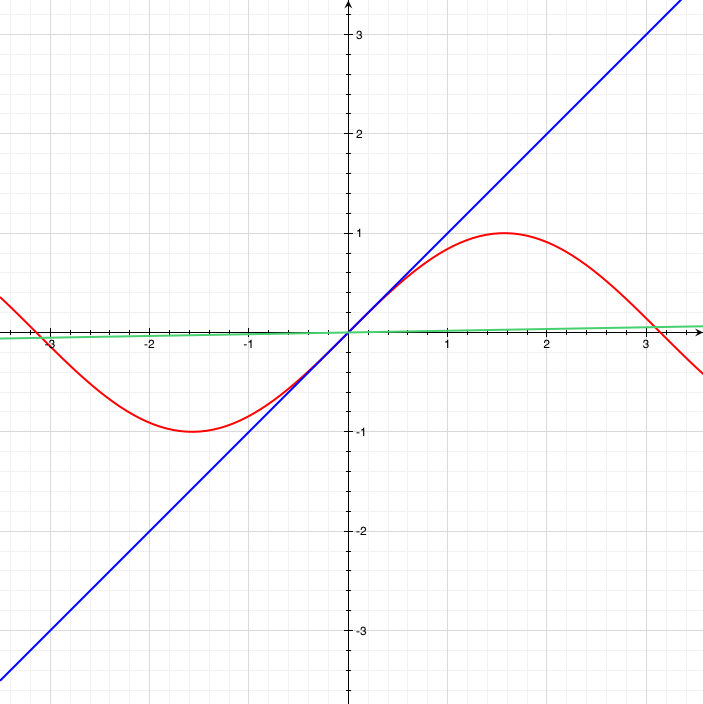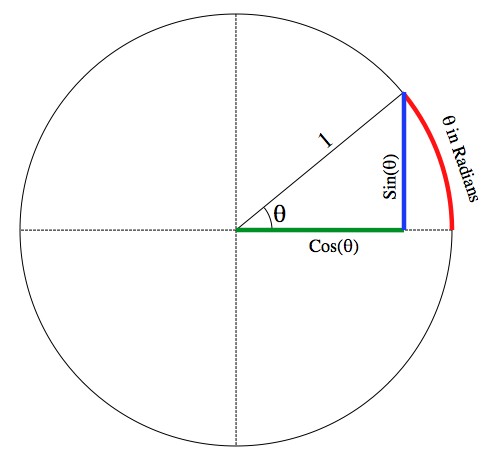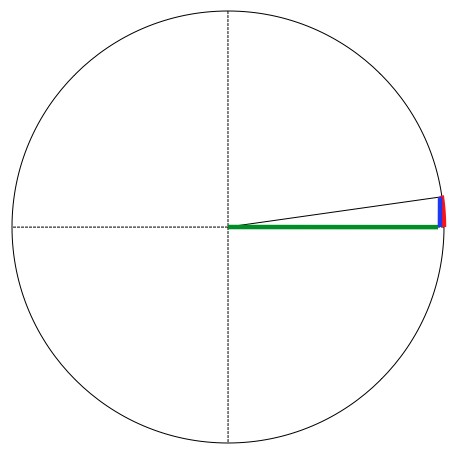Physicist: Because calculus.
When you first start doing trigonometry the choice between radians, degrees, turns, or hexacontades is a matter of personal preference. Most people use degrees because most other people use degrees (and other people seem pretty on the ball). But when you get to calculus using radians is the most natural choice; anything else is just a headache waiting to happen.
To see why you have to get to know the unit circle.
Start with a unit circle with a horizontal line through it and a radius (“a radius” means a line from the center to the edge somewhere). The definition of sine and cosine of the angle between the radius an the horizontal line are in the picture above. SOH CAH TOA is easy in this case because the hypotenuse is 1.
When you use radians you’re describing the angle by using the length of the arc it traces out on the edge of the unit circle. The circumference of a circle or radius R is 2πR, so (since R=1 on the unit circle) the full circle is 2π radians around. That is: 2π radians = 360 degrees.
You’ll notice that when the angle is very small (and measured in radians) the value of sin(θ) and the value of θ itself become very nearly equal. Not too surprisingly, this is called the “small angle approximation” and it’s remarkably useful.
So for small values sin(θ)≈θ or .
In fact, in the limit as the angle approaches zero they are equal, or in mathspeak: . When someone says “in the limit as ___ approaches ___” it means they’re about to talk about calculus (and true to form…). All of the calculus around trig functions can be based on the fact that
. For example, one of the more important things in the world (that’s not quite sarcasm) is the fact that
.
The derivative of a function is , so:
That doesn’t look like a big deal, but keep in mind that all of trigonometry is just a rehashing of sine. For example, and
.
If it weren’t for the fact that (when using radians) we wouldn’t have
.
It’s not the end of the world if you try to do calculus with degrees (it’s close), it’s just that the result is multiplied by an inconvenient constant. For example, if you’re using degrees: . Same thing happens when you differentiate cosine or tangent or whatever. It’s a lot easier to understand why if you look at a graph.

x, sin(x) in radians, and sin(x) in degrees. Notice that when measured in radians sin(x)≈x for small x, and when using degrees sine is really stretched out.
Clearly when using degrees the slope (derivative) of sine at zero is not 1, it’s much smaller (it’s 2π/360 in fact). If you don’t want any weird extra constants, then you need to use radians. But if you don’t mind them, then you be you. You can certainly use degrees or whatever, but you need to be careful with all those extra 2π/360’s.
* This is a trigonometric identity.
** That isn’t obvious:









Pingback: How to Easily Convert Degrees to Radians (and Radians to Degrees) - Gur Times
Pingback: How to Easily Convert Degrees to Radians (and Radians to Degrees) - Your Lifestyle Magazine